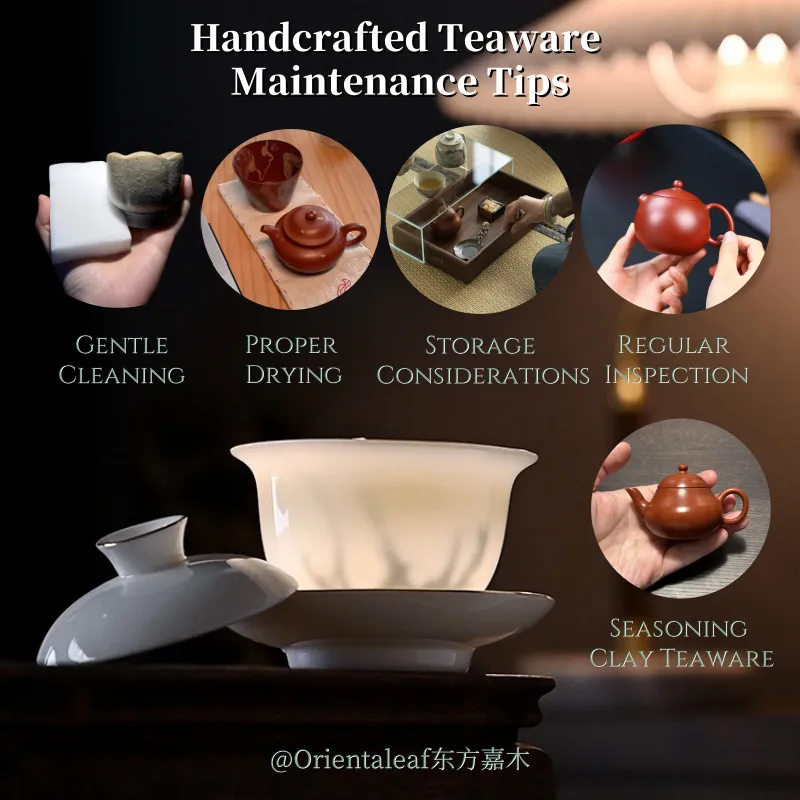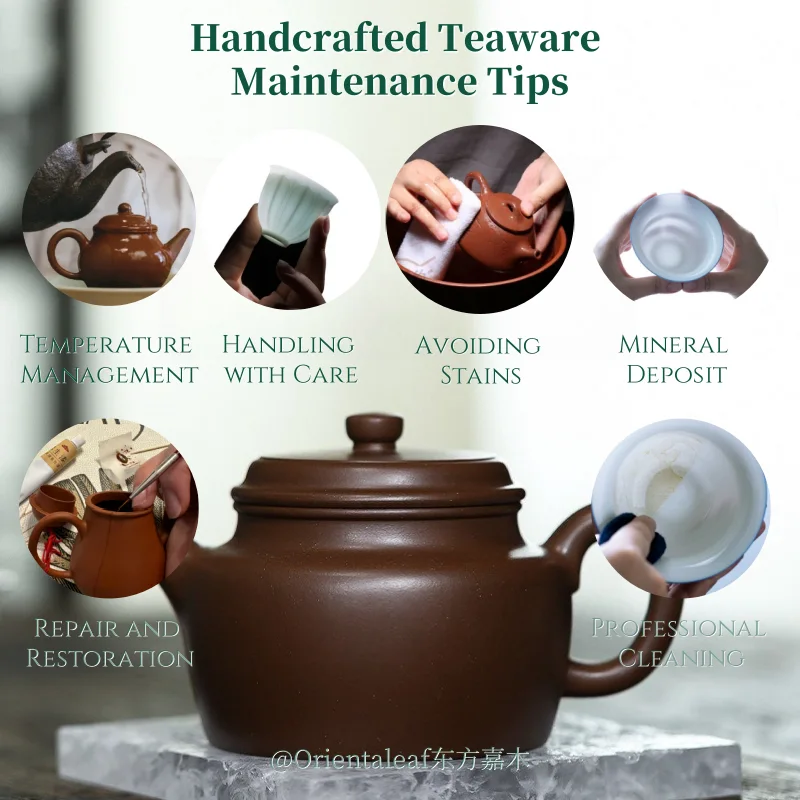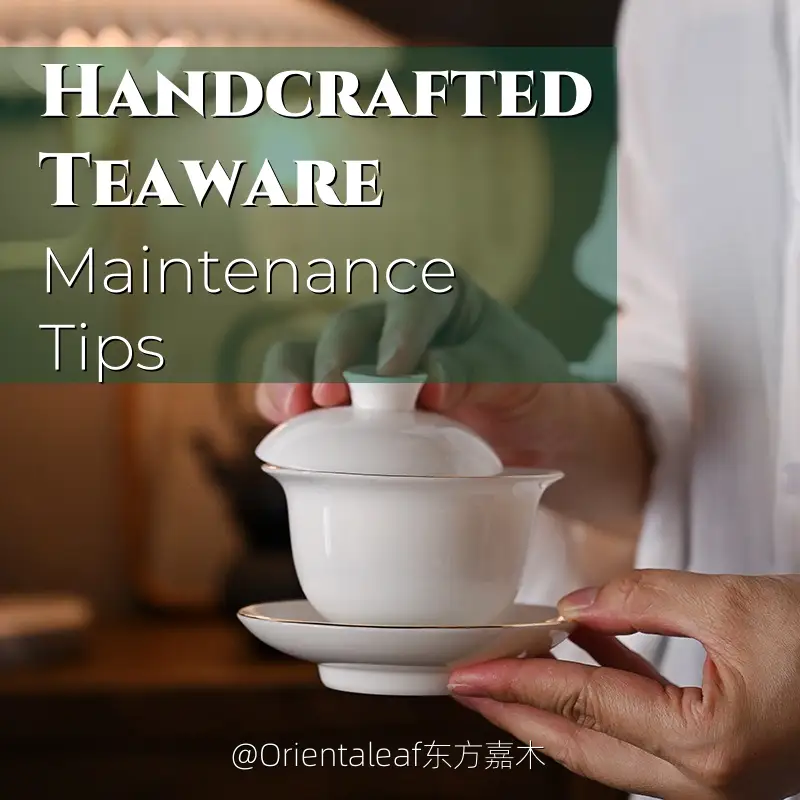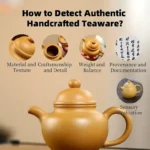Welcome to the world of handcrafted Chinese teaware, where artistry meets functionality in the most exquisite way. If you’ve invested in these beautiful pieces, you know they’re more than just vessels for your favorite brew – they’re works of art that deserve proper care and attention. In this comprehensive guide, we’ll explore essential maintenance tips to keep your handcrafted teaware in pristine condition for years to come.
Handcrafted Teaware Maintenance Tips

Maintaining your handcrafted Chinese teaware is crucial for preserving its beauty and functionality. Let’s delve into some key practices that will help you care for these precious items:
Gentle Cleaning Techniques
When it comes to cleaning your handcrafted teaware, gentleness is paramount. Avoid using harsh detergents or abrasive materials that could damage the delicate surfaces. Instead, opt for a soft, lint-free cloth and warm water. For stubborn stains, a mixture of baking soda and water can work wonders without causing harm.
Proper Drying Methods
After cleaning, it’s essential to dry your teaware thoroughly to prevent water spots and potential damage. Air drying is often the best method, but be sure to place your items on a soft, absorbent surface. For items with intricate designs or hard-to-reach areas, consider using a soft brush to remove any lingering moisture.
Storage Considerations
Proper storage is crucial for maintaining the integrity of your handcrafted Chinese teaware. Store your items in a cool, dry place away from direct sunlight, which can cause fading or discoloration. Consider using padded dividers or soft cloth wraps to prevent scratches and chips when storing multiple pieces together.
Regular Inspection
Make it a habit to inspect your teaware regularly for any signs of wear or damage. Early detection of small cracks or chips can prevent more significant issues down the line. If you notice any problems, consult with a professional specializing in handcrafted teaware restoration for advice on repairs.
Seasoning Clay Teaware
For unglazed clay teaware, such as Yixing pots, proper seasoning is essential. This process involves brewing tea in the pot and allowing it to absorb the flavors and oils. Over time, this creates a natural patina that enhances the tea-brewing experience. Remember to use only one type of tea per pot to maintain the integrity of the flavors.
Handcrafted Teaware Maintenance Tips You Must Know

Now that we’ve covered the basics, let’s explore some advanced maintenance tips that every handcrafted Chinese teaware enthusiast should know:
Temperature Management
Handcrafted teaware, especially those made from delicate materials like porcelain, can be sensitive to sudden temperature changes. To prevent thermal shock, which can lead to cracks or breakage, avoid exposing your teaware to extreme temperature fluctuations. When brewing hot tea, warm the vessel gradually by rinsing it with warm water before adding boiling water.
Handling with Care
Always handle your handcrafted teaware with clean, dry hands to avoid transferring oils or dirt that could stain or damage the surface. When moving pieces, support them from the base rather than holding them by handles or spouts, which may be more fragile.
Avoiding Stains
Some teas, particularly dark varieties like pu-erh or black tea, can leave stains on lighter-colored teaware. To minimize this, rinse your teaware immediately after use and avoid letting tea sit in it for extended periods. If stains do occur, a paste of baking soda and water applied gently can help remove them without damaging the surface.
Mineral Deposit Management
Over time, mineral deposits from water can build up on your teaware, especially in areas with hard water. To combat this, periodically soak your teaware in a solution of equal parts white vinegar and water for about 30 minutes, then rinse thoroughly and dry. This natural method is safe for most types of handcrafted Chinese teaware.
Professional Cleaning
For particularly valuable or delicate pieces, consider having them professionally cleaned once a year. Experts in handcrafted teaware can use specialized techniques to clean and maintain your items without risking damage.
Repair and Restoration
If your handcrafted teaware becomes chipped or cracked, resist the urge to attempt repairs yourself. Seek out a professional who specializes in restoring handcrafted Chinese teaware. They can often perform nearly invisible repairs that will preserve both the beauty and value of your pieces.
Can Handcrafted Teaware Get Worn Out if Not Maintained?
The short answer is yes, handcrafted teaware can indeed wear out if not properly maintained. However, with the right care, these exquisite pieces can last for generations. Let’s explore the potential consequences of neglect and how proper maintenance can prevent them:
Surface Deterioration
Without regular cleaning and proper care, the surfaces of handcrafted Chinese teaware can become dull or develop a film that detracts from their original beauty. This is particularly noticeable on glazed surfaces, where the luster can diminish over time if not maintained.
Structural Integrity
Neglecting to address small cracks or chips can lead to more significant structural issues. What starts as a minor imperfection can grow into a larger crack that compromises the entire piece. Regular inspection and prompt professional repair can prevent this type of deterioration.
Flavor Contamination
For unglazed clay teaware, improper maintenance can lead to flavor contamination. If these pieces are not cleaned correctly or are used for multiple types of tea, the flavors can mix, altering the taste of your brew. Consistent care and dedicated use for specific teas can preserve the intended flavor profile.
Staining and Discoloration
Light-colored teaware, in particular, is susceptible to staining if not cleaned promptly after use. Over time, these stains can become permanent, altering the appearance of your handcrafted pieces. Regular cleaning and stain prevention techniques can keep your teaware looking pristine.
Loss of Functionality
Teapots and kettles with moving parts, such as lids or pour spouts, can become less functional if not maintained. Mineral buildup or damage to these components can affect their performance, potentially rendering the piece unusable for its intended purpose.
Conclusion
In conclusion, the maintenance of handcrafted Chinese teaware is not just about preserving physical objects; it’s about honoring the artistry and tradition behind each piece. By following these maintenance tips and treating your teaware with the respect it deserves, you’ll not only extend its lifespan but also enhance your tea-drinking experience for years to come. Remember, each time you brew tea in a well-maintained piece of handcrafted teaware, you’re participating in a centuries-old ritual that connects you to the rich history of Chinese tea culture.
We serve thousands of satisfied tea enthusiasts in our tea house each year, and we’re excited to share these exceptional teas with tea lovers worldwide at Orientaleaf.com.

References
- Jing, H. (2019). The Art of Chinese Tea. Beijing: Cultural Relics Publishing House.
- Zhang, L. (2020). Caring for Yixing Teaware. Tea Quarterly, 45(2), 78-92.
- Chen, W. (2018). Traditional Chinese Tea Ceremonies and Teaware. Shanghai: East China Normal University Press.
- Liu, Y. (2021). The Collector’s Guide to Antique Chinese Teaware. Hong Kong: Sotheby’s Institute of Art.
- Wang, X. (2017). Preservation Techniques for Delicate Ceramics. Journal of Cultural Heritage Conservation, 12(3), 201-215.


